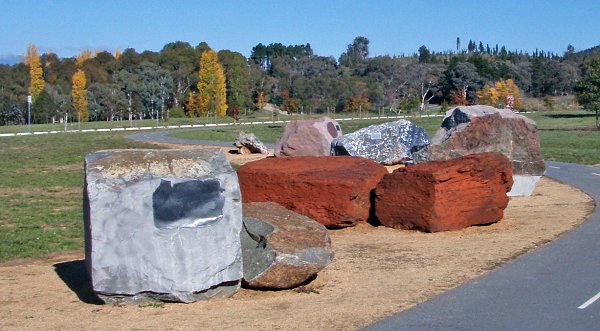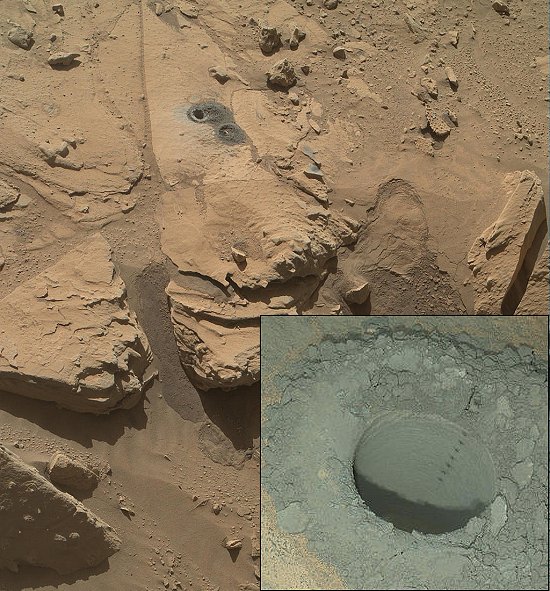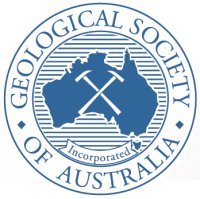|
|

|
|
|
|
|
|
|
|
|
|
|
|
|
|
|
|
|
|
|
|
|
|

|
geoz 91 May 2014
NEWSBREAKERS
Big just got bigger - maybe!
A new Cretaceous sauropod is thought to be yet another species of titanosaur. Found in Patagonia, its huge thigh bone has led researchers to conclude it stood 20m tall, was about 40m long and weighed in at around 77 tonnes. Since there is no complete skeleton debate as to whether it is the biggest animal to ever walk the Earth is yet to be resolved.
http://bbc.in/1nYM7xp
FROM THE DIVISIONS
Divisional information is regularly updated at http://gsa.junctionworld.com/events/divisionmeetings.html
Check this site for more recent information on the following events:
Australian Capital Territory
Regular meetings 2014: Third Tuesday of each month (Except January)
Jaeger Lecture Theatre, Jaeger Building (Building 61), Australian National University. 5.00pm for 5.30pm start.
For more information: emma.mathews@ga.gov.au
New South Wales
Thursday 22nd May 2014
Laurie Hutton, President Geological Society of Australia
Critical metals
University of New South Wales, Biosciences Building, Biomed Theatre A. 5.30 pm for 6.00 pm
Queensland
2014 meeting dates to be advised
For more information: info@qld.gsa.org.au
Every Wednesday evening: GeoPub
Weekly Informal get-together for Explorers, Miners & other Geoscientists
O'Malleys Irish Pub - Basement Level of the Wintergarden in the Queen Street Mall, Brisbane. 5.30 pm
South Australia
Thursday 22nd May 2014
Dr. Simon Holford, Australian School of Petroleum
The origin of the Ceduna sub-basin, Great Australian Bight
Mawson Theatre, University of Adelaide. 5.30 pm for 6.15 pm
GeoNight at the Pub: First Thursday of each month (starting 6th February)
The Griffins Head, Hindmarsh Square, Grenfell Street, Adelaide (Front Bar), 5.00pm to 7.30pm
For more information: anna_petts@yahoo.com.au
Tasmania
2014 meeting dates to be advised
For more information: taryn.noble@utas.edu.au
Victoria
Thursday 29th May 2014
Dr Twycross
The pioneering work in seismography of John Milne
Mueller Hall, Royal Botanical Gardens, 7 pm followed at 8pm by a Night Sky Tour
Please note that numbers are limited to 30. For details of how to register please read the Division newsletter.
Western Australia
Regular meetings: First Wednesday of each month (except December and
January)
Irish Club of WA, 61 Townshend Road, Subiaco, 5.30pm
For more information: info@wa.gsa.org.au
GSA EVENTS
GSA Council Elections
In July 2014, the Governing Council will be implemented. The process of electing the new Governing Council of GSA is now in progress.
Call for General Councillors
The Executive is now calling for nominations for the five positions of General Councillor to complete the inaugural nine person Council. As advised in numerous communications, the Governing Council will combine the authority of the current Executive and the biennial Council meeting. The five General Councillors will be determined by a ballot of all members and the new Council will be endorsed on 8th July 2014, at the 2014 AGM of the Society, to be held in association with the AESC in Newcastle.
The Nomination process: Nominations are open to almost all membership categories (click here for full details), subject to endorsement by two Full or Retired Members. Nominations closed 21st May, 2014, and ballot papers will be mailed to all Members by 31st May with voting to close by 30th June. The General Councillor Nomination form is available here.
Your Nomination should include:
A summary of qualifications to serve as a Councillor (maximum of 400 words) which includes:
a. Academic, professional and community qualifications and recognition;
b. Relevant work and board/committee experience;
c. Portrait image of yourself (optional)
d. Contributions to GSA and
e. Key issues that you believe that GSA needs to address.
It should be forwarded to: info@gsa.org.au by no later than 21st May, 2014.
Additional Information:
The new governance model has been developed to strengthen the strategic decision making and development of the GSA, and to revitalise an organisation that has hardly grown its membership during the recent period of increased interest and enrolments in geoscience. It will meet quarterly by teleconference with one face to face meeting each year. Substantial authority will be delegated to the CEO and a smaller Executive, drawn from within Council, to ensure prompt response to opportunities and issues. The President will be appointed from the elected Council.
Membership of the new Council will be a significant, national, professional responsibility, and an exciting opportunity for any Member committed to our profession, its standing and its growth. An ideal Council will include a mix of attributes such as: vision and a national perspective; energy and enthusiasm; wisdom; business acumen and management experience; experience in GSA committees; and recognition within the profession. We are starting an exciting new chapter in the evolution of GSA and here is your opportunity to shape the future of the Society.
If you have any queries about the nomination process, or what may be involved in becoming a Councillor, please contact sue@gsa.org.au or one of the Governance committee members: Jim Ross, Chris Yeats, Laurie Hutton laurie.hutton@dnrm.qld.gov.au or Ian Graham i.graham@unsw.edu.au
The Australian Earth Sciences Convention 2014
Field trips and workshops registration deadline is this Friday!
The deadline is fast approaching to register for AESC field trips and workshops. The deadline for field trips and workshops is Friday, 30 May. See http://www.aesc2014.gsa.org.au/workshops-and-field-trips/ for details.
Newcastle accommodation filling up! There is another event on in Newcastle during the AESC which means accommodation will be extremely hard to come by. The Secretariat has block bookings in place at a number of hotels. However, all unsold rooms must be released back to the hotels 30 days prior to the convention. We highly recommend you book your accommodation sooner rather than later to avoid disappointment.
The convention themes are:
• Energy
• Resources
• Environment
• Infrastructure, Service and Community
• Dynamic Planet
• Living Earth
Dedicated symposia include:
• 39th Symposium on the Advances in the Study of the Sydney Basin
• Comparisons & Contrasts in Circum-Pacific Orogens

Exploring in Australia?
Then you may be interested in these talks at the AESC:
• New exploration techniques and models, including bioexploration
• Multiscale characterisation of ore forming processes
• Latest developments in analytical geochemistry and geochronology
• Intrusion-related and orogenic gold deposits
• Geophysical & geochemical evidence of structure of the deep subsurface
• Coal Seam Gas and groundwater
• Public Forum on Energy 2050
• Petroleum prospectivity exploration and modelling of proven
and frontier basins
• The 39th Sydney Basin Symposium
• Coal - An old resource in a new age
• The Thomson Orogen in Queensland and NW NSW
• Nuclear Energy
• Magnetic anomalies and geological interpretation
• Optical sensing for advanced mineral characterisation for exploration
and mining
• UNCOVER - Searching the deep earth
• Geological challenges on major engineering/infrastructure projects
Image courtesy of Mike Smith.
Please distribute information about the AESC 2014 to your colleagues within the geoscience community.
Australian Earth Sciences Convention
AESC 2014: Sustainable Australia
7-10 July 2014
Newcastle NSW
The organising committee looks forward to welcoming you in Newcastle and if you want any information about the AESC do not hesitate to contact the Convention secretariat: aesc@willorganise.com.au.
The National Rock Garden beds down for winter

National Rock Garden panorama.
Image courtesy of Brad Pillans.
The first frosts for the year have chilled the Federation rocks but the place is looking better than ever.
In addition to the Federation Rocks the National Rock Garden (NRG) will have up to 100 large specimens of the country's most iconic rocks. Each specimen will weigh approximately 10-15 tonnes. To find out how you can contribute follow this link to the NRG web site: http://www.nationalrockgarden.org.au/
The NRG qualifies for Deductible Gift Recipient status. In other words, donations to the NRG are tax deductible so now donating to the NRG can be a win-win! Bookmark this page: http://bit.ly/1gl0K8d
If you would like to join the Friends of the National Rock Garden and receive newsletters and information directly by email please send a request to rockgarden@gsa.org.au. Download the latest newsletter here.
Stay up to date with the latest NRG news by liking the Facebook page:
https://www.facebook.com/pages/National-Rock-Garden/509206615828657?ref=hl
IN THE NEWS
Humans stirring the seismic pot
Research reveals human extraction of groundwater is increasing the number of small earthquakes in California with pumping and irrigation causing mountain uplift and valley subsidence. The long term concern is that this seismic activity along the San Andreas fault will hasten the occurrence of large quakes.
News report: http://bbc.in/1o9H5OM
Research abstract: http://bit.ly/1tdx8BZ
Ernabella earns a gong
Ernabella (Pukatja), a remote northern South Australian community, has recorded the largest earthquake in Australia for two consecutive years. In both 2012 and 2013 a 5.7 magnitude event rattled the region, making it one of the few places in Australia to record several large events over time.
http://bit.ly/R32sVG
ON THE WEB
Self-help book for scientists
Research students, early career researchers and many others in science will find this book helpful since it is based on extensive scientific research and management experience. It describes how to establish projects, manage them and develop communication. It has illustrations from case studies and is available for free download in PDF, EPub or Mobi formats.
Download from here: http://bit.ly/Tkx6vK
Antarctic ice losses double
Cryosat data reveals Antarctica is losing about 160 billion tonnes of ice a year. This is twice as much as observed in the last survey and will raise global sea levels by around 0.43mm per year.
News report: http://bbc.in/1ndgzmb
Research abstract: http://bit.ly/1naRE6U
IN THE MEDIA

Baby mammoth on display
A baby mammoth named Lyuba has gone on display at the Natural History Museum in London. This mammoth died 42,000 years ago when it weighed about 50kg and was 130cm tall.
http://bbc.in/1ghK8UJ
Magma Arta
A collection in the Sedgwick Museum, dating back to the early 1800s, holds about 160,000 rock specimens and about 250,000 thin-sections. It is a unique collection of igneous materials from around the world that is now allowing researchers to investigate the geochemistry of the rocks & minerals and their correlation with the seismic properties of the regions from which they came.
http://bit.ly/RmQozk
InaSAFE 2.0
The updated version of InaSAFE 2.0, jointly developed by Indonesia's National Disaster Management Agency, Australian Government agencies and the World Bank, has been released and is available for free download. The InaSAFE tools help improve disaster preparedness in Indonesia by providing a new way to combine scientific hazard information and community knowledge on disaster. The World Bank is encouraging the use of InaSAFE across the world where ever disaster preparedness is needed.
http://bit.ly/1h2ZeIU
Mars: The field trip continued

Main image: http://1.usa.gov/1kktVOi
Image courtesy of NASA/JPL-Caltech/MSSS
Inset image: http://1.usa.gov/1lXWd0Ji
Image courtesy of NASA/JPL-Caltech/MSSS
The main image shows the location of a test drill hole in the rock known as Windjana. The inset image shows the drill hole used to sample material from the interior of the rock and a series of target points inside the hole created by the Chemistry and Camera (ChemCam) instrument's laser. The hole 1.6 centimetres in diameter.
More news from the solar system ...
Venus Express suicidal swan dive
http://ab.co/1o9DJv9
... and elsewhere ...
Nearby fossil stars
http://ab.co/1jkC8lf
What's in AJES
The Australian Journal of Earth Sciences online is available through the Taylor & Francis website. It is very easy to navigate and use.
AJES is available to financial members of the GSA. Don't miss the next issue because your membership has lapsed!
Volume 61 No.2 - Hard Copy now available
M. Rexer & C. Hirt
Comparison of free high resolution digital elevation data sets (ASTER GDEM2, SRTM v2.1/v4.1) and validation against accurate heights from the Australian National Gravity Database
R. H. Vernon
Microstructures of microgranitoid enclaves and the origin of S-type granitoids
F. L. Sutherland, I. T. Graham, J. D. Hollis, S. Meffre, H. Zwingmann, F. Jourdan & R. E. Pogson
Multiple felsic events within post-10 Ma volcanism, Southeast Australia: inputs in appraising proposed magmatic models
Stephen J. Barnes, L. A. Fisher, R. Anand & T. Uemoto
Mapping bedrock lithologies through in situ regolith using retained element ratios: a case study from the Agnew-Lawlers area, Western Australia
M. J. Cracknell, A. M. Reading & A. W. McNeill
Mapping geology and volcanic-hosted massive sulfide alteration in the Hellyer-Mt Charter region, Tasmania, using Random Forests™ and Self-Organising Maps.
A. S. A. A. Abu Sharib
Switching bulk horizontal shortening and regional-scale partitioning of deformation during the Isan Orogeny in the Eastern Fold Belt, Mount Isa Inlier, Australia.
M. A. Short, S. Lamontagne, P. G. Cook & R. Cranswick
Characterising the distribution of near-shore submarine groundwater discharge along a coastline using 222Rn and electrical conductivity
Volume 61 No.3 - Sydney Basin
Colin Ward, Adrian Hutton, Harry Bowman, Kaydy Pinetown (eds)
C. R. Ward, A. C. Hutton, H. N. Bowman & K. L. Pinetown
Geological advances in the Sydney Basin: introduction to the thematic issue.
D. Och, I. Graham, H. Zwingmann, R. Offler & L. Sutherland
Constraining timing of brittle deformation and fault gouge formation in the Sydney Basin.
B. J. Franklin, J. F. Young & R. Powell
Testing of Sydney dimension sandstone for use in the conservation of heritage buildings.
G. H. McNally & D. F. Branagan
Geotechnical consequences of the Newcastle Coal Measures rocks.
L. Zhao, C. R. Ward, D. French & I. T. Graham
Mineralogy and major element geochemistry of the lower Permian Greta Seam, Sydney Basin, Australia.
S. Thomson, D. Thomson & P. Flood
Observations on the distribution of coal seam gas in the Sydney Basin and the development of a predictive model.
K. L. Pinetown
Regional coal seam gas distribution and burial history of the Hunter Coalfield, Sydney Basin.
A. Burra, J. Esterle & S. Golding
Coal seam gas distribution and hydrodynamics of the Sydney Basin, NSW, Australia.
A. Saghafi
Estimating greenhouse gas emissions from open-cut coal mining: application to the Sydney Basin.
J. Ross
Groundwater resource potential of the Triassic sandstones of the southern Sydney Basin: an improved understanding.
D. I. Cendón, S. I. Hankin, J. P. Williams, M. van der Ley, M. Peterson, C. E. Hughes, K. Meredith, I. T. Graham, S. E. Hollins, V. Levchenko & R. Chisari
Groundwater residence time in a dissected and weathered sandstone plateau: Kulnura-Mangrove Mountain aquifer, NSW, Australia.
B. F. J. Kelly, W. Timms, T. J. Ralph, B. M. S., Giambastiani, A. Comunian, A. M. McCallum, M. S. Andersen, R. S. Blakers,R. I. Acworth & A. Baker
A reassessment of the Lower Namoi Catchment aquifer architecture and hydraulic connectivity with reference to climate drivers.
Other papers published on-line recently
Follow this link to see the most recent papers published on-line.
I. C. Roach, S. Jaireth & M. T. Costelloe
Applying regional airborne electromagnetic (AEM) surveying to understand the architecture of sandstone-hosted uranium mineral systems in the Callabonna Sub-basin, Lake Frome region, South Australia
A.Y. Glikson & A.H. Hickman
Coupled asteroid impacts and banded iron-formations, Fortescue and Hamersley Groups, Pilbara, Western Australia
C. L. Fergusson
Late Ordovician to mid-Silurian Benambran subduction zones in the Lachlan Orogen, southeastern Australia
Coming up in TAG
TAG for June 2014
The June issue is in production. The September issue deadline is 25 July. Have you got something to say in 2014? Get your Letter to the Editor or a news item published in TAG by sending it to: tag@gsa.org.au. If you are submitting a Feature or Special Report please send your article in as soon as possible. Need information about word lengths and submitting? Contact: tag@gsa.org.au
JOB VACANCIES
Advertising space now available

Advertising positions are now available in Geoz. Be the first to advertise here.
Word length: 40-50 words (the shorter the more effective) plus link to a web site.
Text and a small logo linking to your online advert or business.
Logo a maximum of 180 pixels wide x 90 pixels high.
Adverts will run in Geoz for two issues.
Fee: $150.00
For more information: info@gsa.org.au
WHAT'S ON
DEADLINES:
Call for Papers - Abstract deadline June 30 2014
Bowen Basin Symposium 7-10 October, 2015
Bowen Basin and Beyond
Click here for flyer
Geoscience Australia's 2014 Top GeoShot photographic competition - entries close 12 September 2014
Winners receive a professionally framed enlargement of their image and their image will be displayed in Geoscience Australia's foyer in Canberra for the year.
EVENTS:
Broken Hill Resource & Energy Symposium, Broken Hill, 25 – 28 May 2014
Australia's most informative resources conference.
http://bit.ly/1gNtaru.
The pioneering work in seismography of John Milne, Melbourne, 29 May 2014
Night Sky Tour.
Contact secretary@vic.gsa.org.au for more details.
Dinosaur & Marine reptile Dig! Richmond, QLD, 6 – 12 July 2014
For more information contact: paul@stumkatstudios.com
Australian Earth Sciences Convention - AESC 2014, Newcastle, NSW, 7 – 10 July 2014
1st Circular available NOW.
http://bit.ly/17ZRWUi
Practical Rock Mechanics (Introduction) Short Course, Perth, 28 – 29 July 2014
Click here for more information
Ground Support in Mining (Introduction) Short Course , Perth, 30 July – 1 August 2014
Click here for more information
9th International Mining Geology Conference 2014, Adelaide, 18 – 20 August 2014
Click here for more information
Open Pit Geotechnical Analysis and Design Training Course, Perth, 26 – 28 August 2014
31st Annual Meeting of the Society for Organic Petrology, Sydney, 27 September – 3 October 2014
CONTACTS
Head Office
Suite 61, 104 Bathurst Street
Sydney NSW 2000
ph 02-9290 2194
fax 02-9290 2198
www.gsa.org.au
Executive
Divisions
Specialist
Groups
The Australian Journal
of Earth Sciences (AJES)
The Australian
Geologist (TAG)
Education and Outreach
Publicity
GEOZ advertising
|
|
|

|

|
|
|

|
|
